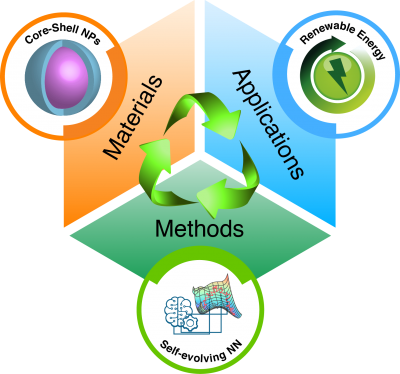Developing inexpensive and earth-abundant alternatives to precious-metal-based catalysts for chemical transformation is one of the predominant challenges in the quest of building a sustainable energy future. Research in our lab aims to develop a fundamental understanding of complex materials and their applications for energy conversion and storage. The proposed research program is firmly grounded in theory by bridging and integrating the three components: material design, application innovation, and method development, all of which further will be validated in the synergy between theory and experiment. Three projects, namely, core@shell metal oxide, metal phosphides for water electrolysis, and self-evolving neuron network potential, are proposed below, representing these three primary focuses of our research.

1. Metal Oxides for Energy Conversion and Storage
Core-shell structure is a promising architecture for next-generation catalysts with high activity, robustness, and tunability. The proposed research will focus on the structure-property correlation for core-shell metal oxide nanostructures as well as its applications for “independently tunable” oxide supports and rechargeable metal-air batteries, as explained in the following two projects:
Project 1(a): Subsurface engineered metal oxides as “independently tunable” supports. An oxide support, of which the surface reducibility can be independently tuned without modifying the surface structure, is an ideal model system to study the metal-oxide interaction for oxide-supported catalysts. We will develop subsurface engineered metal oxides (SEMO) for the above desired "independently tunable" supports, of which the surface reducibility is precisely controlled by the subsurface substitution. We will perform DFT simulations of reverse water gas shift (RWGS) on a series of SEMOs to elucidate the effect of support reducibility on particle morphology, overall conversion, and specific selectivity. In the long term, SEMO will provide a novel scheme to design highly active and selective oxide-supported metal catalysts.
Project 1(b): Alloy-core@shell perovskites for cathode materials of rechargeable metal-air batteries. We propose the design of perovskite-based alloy-core@shell architecture, of which one unit cell (u.c.) of SrTiO3 protects 2-3 u.c. of alloyed perovskites. Different alloying strategies will be examined using density functional theory (DFT) to build the correlation between subsurface composition and surface reactivity. Furthermore, a general scheme will be developed to predictively design alloy-core@shell perovskite structures for cathode materials of rechargeable metal-air batteries.

2. Transition Metal Phosphide Catalyst for Water Electrolysis
Water electrolysis, consisting of the hydrogen evolution (HER) and the oxygen evolution (OER), is one of the most attractive technologies for sustainable hydrogen production. Transition metal phosphides (TMPs) hold the promise for earth-abundant and efficient catalysts for both HER and OER. The following two projects are proposed to specifically tackle the prevailing challenges of applying TMPs for water electrolysis, namely (a) engineering the TMP materials for better HER performance, (b) understanding the OER chemistry on TMPs.
Project 2(a): Transition metal@phosphide core-shell nanoparticles for the HER. Novel transition metal@phosphide (TM@TMP) NPs will be studied for the HER, where the TM core can fine-tune the performance of the out-most phosphide shell. A comprehensive theoretical investigation will be conducted to examine the HER performance and thermodynamic stability for various TM/TMP combinations. Ultimately, we aim to develop a general theoretical framework to study and design TM@TMP NPs for energy-related applications.
Project 2(b): Fundamental understanding of the OER chemistry on TMPs. It is now well accepted that the OER active phase is the transformed phosphide-oxide/hydroxide (TMP/TMOxHy) heterostructure. However, it is still ambiguous that many of these TMP-transformed catalysts exhibit superior activities to their oxide or oxyhydroxide counterparts. Herein, theoretical studies using a TMP/TMOxHy over-layer model system will be performed to examine the following possible promotion effects: 1) charge transfer between TMP substrate and TMOxHy surface, 2) synergistic effect from the surface incorporated P, 3) phosphate ion acts as a catalytic promoter for the OER.

3. Self-learning Artificial Neural-Network Potentials for Molecular Dynamics
Recently, machine learning techniques, especially artificial neural networks (ANN), have been shown to predict properties of materials with reasonable accuracy and efficiency. However, most of the machine learning techniques train the potential prior to simulation and lack the inclusion of atomic forces.
Here, We are developing an MD coupled self-evolving artificial neural-network (SE-ANN) potential. The proposed method begins with a fixed length of ab initio MD on the first principle potential energy surface and trains the initial ANN potential using a multi-target feed-forward NN. By including the force vector (i.e., the gradient of the potential energy surface) in the output layer, we expect an improved training speed and efficiency. When the accuracy is under preset criteria during simulation, our method evolves the ANN potential using back-propagation algorithm until the quality of prediction is recovered. In the long term, we will implement our method to an open source package and apply it to investigate the dynamic coupling between morphology evolution and catalytic performance for NPs with a realistic size.
